Yala is Sri Lanka’s most visited national park. Ironically, it previously served as hunting grounds for the British elite. The park is divided into five blocks, some of which are not easily accessible to visitors. The most popular one is Block One which is home to approximately 20 leopards!
While Yala is known for its leopards, it’s also worth noting that there are 44 species of mammals (including elephants) and an incredible 215 bird species! Wildlife tip: Appreciate what you see! Your chances of seeing a leopard are good, but they are wild animals, so it’s also possible that you won’t see one. So many people are focused on only seeing a leopard that they get blasé about what would otherwise be considered really incredible animal sightings. Watch for an upcoming post about the other wildlife you can see in Yala!
But for now, I’m going to focus solely on the leopards, because I can see you saying, Yeah, yeah, I know, there’s other wildlife, but tell me about the leopards and how likely I am to see one!
Leopards eluded me on my previous four trips to Africa! On three separate occasions I had seen fresh leopard tracks, and once even minutes old poop, but no leopard! The most frustrating experience was at Tembe Elephant Park in South Africa, where we kept spotting fresh tracks on the road, that would disappear into the bush, then reappear again. This went on for over 90 minutes! It seemed as if the leopard was playing a game of cat and mouse – and one that he clearly won!
When trying to decide which national parks to visit in Sri Lanka, I choose Yala for one reason: leopards! I hoped that on a new continent, they would not continue to elude me and be into playing games!
I went to Yala National Park three times and incredibly saw leopards every single time! I saw one leopard the first time, three leopards (a mother and her cubs) the second time and two leopards the third time! My luck was truly incredible! Dave and Deb from The Planet D were also fortunate enough to spot a leopard in Yala, while Sherry from Otts World, had no such luck with leopards, not seeing any unfortunately. That’s why I recommend more than one visit to Yala, it will significantly increase your chances of spotting a leopard and other wildlife.
I will admit that the first sighting was far away. Even with our guide pointing him out to me in the tree approximately 30 meters away, it still took me about 10 minutes before I could find it. Here’s what he looked like:
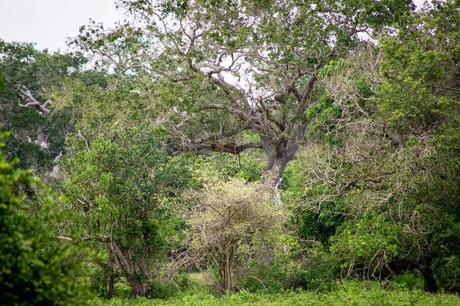
1st leopard sighting
…and that’s with a zoom lense!
My second time in Yala, I was visiting with Leopard Trails, and got closer, approximately 15 meters away. Our jeep was fortunate enough to grab a good position and while I didn’t get a photo of the mother and both of her cubs, I did get one of the cubs who was moving around a bit through the bush and came out just long enough for me to get these photos:
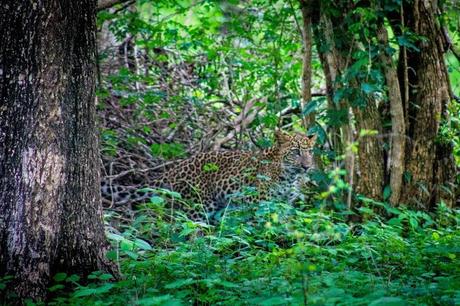
Second leopard spotting at Yala, a cub ~18 months old.
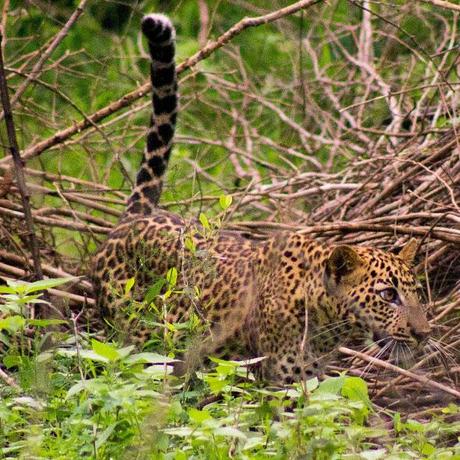
My third time also with Leopard Trails was a matter of being in the right place at the right time. We got a call about a leopard sighting and fortunately we were just a few meters away. The leopard cub was in a tree just a few meters from the road and we were one of the first jeeps to arrive. Despite being so close, he was still difficult to see as he was so well hidden by the leaves:
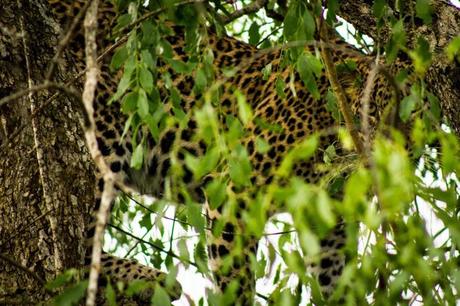
Despite him just being a few meters away, the leopard was difficult to see.
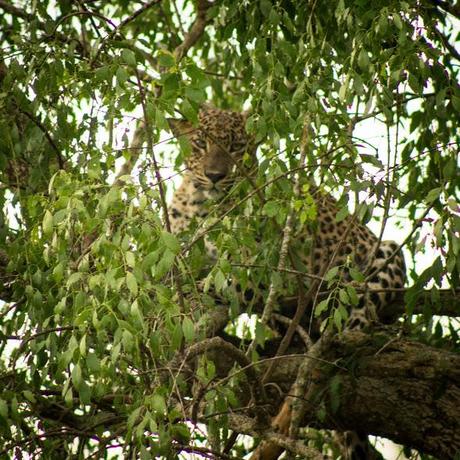
A few of the jeep drivers got excited and pulled in closer and closer to give their guests a better viewing opportunity. This agitated the poor leopard, who then decided to seek out solace, which meant he had to climb down the tree and crossed the road several meters from our jeep as he did so to meet up with his mother! This resulted in a leopard viewing of a lifetime:
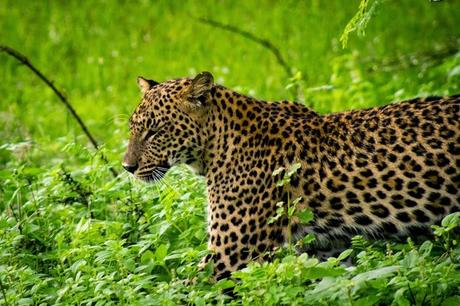
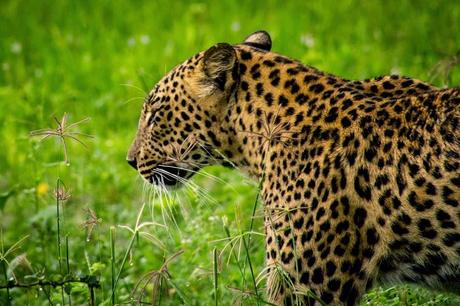
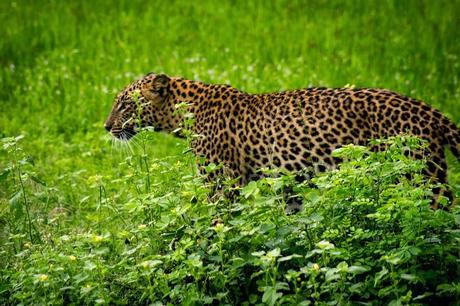
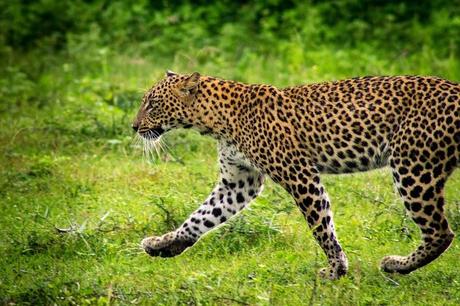
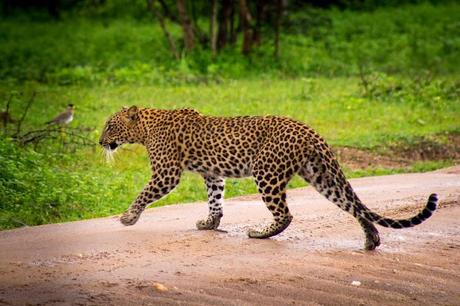

The last glance of the leopard before he disappeared into the thick brush.
Having said that, I felt and still feel badly for the leopard. Our guide Jerome sadly shook his head and said; In 10 years it will be virtually impossible to see a leopard in Yala, we will have scared them all away. Unfortunately, I have to agree with him. I loved my time in Yala, but was very disappointed to see how little respect some of the drivers had for wildlife by getting too close or revving their engines. And it’s not just one or two jeeps, there are dozens of them, resulting in jeep jams along the road. I get that everyone wants to see a leopard, I know I certainly did, but not at the leopard’s expense where we are interfering with their natural behavior. Had all the jeeps stayed a few meters further back on the road, it’s likely the leopard would have stayed undisturbed in his tree. Given the choice, I would have gladly sacrificed my photo opportunity for the wellbeing of the leopard.
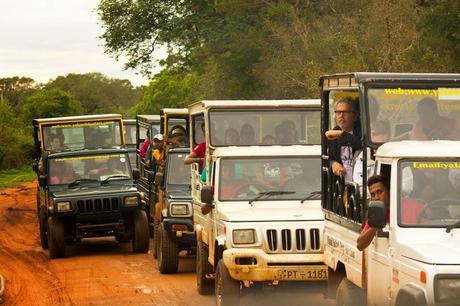
Everyone trying to get a glimpse of the leopard, which ultimately scared him off, when some jeeps got too close.
That’s why I strongly believe it’s crucial to visit Yala with a reputable company like Leopard Trails that employ experienced eco-minded guides like Jerome, who will let the drivers know if they are getting too close. It’s easy to put all the blame on the Sri Lankans and say they need better trained drivers and to have enforced guidelines about how close a jeep is allowed to get to wildlife, or limit the number of jeeps allowed in the park at one time. While these certainly may be part of the solution, eco-tourists also have to take some responsibility. The drivers and guides are catering to our needs as tourists advise the guides Closer, closer, I can’t see around the other jeeps, and I want a better photo. I must have heard some variation of this a hundred times, and more often than not, the driver would comply if they could, knowing that they may get a better tip for doing so.
Instead, we need to think about what’s best for the animal, and not for our photo opp, perhaps asking the driver to back off a bit to give the animal room. Tourism is just returning to Sri Lanka after a long civil war and there’s much to be learned from both sides, and as eco-tourists we also have a responsibility. It’s in the best interest of wildlife and Sri Lankans if can ensure that future generations will can have the same incredible leopard spotting opportunities that I had, which was honestly one of the most AAAAMAZING wildlife encounters I have ever had!
Know Before You Go Leopard Spotting in Yala National Park:
- If at all possible, go more than once. I went once with another safari company and twice with Leopard Trails who provides two safaris each day for their guests as part of their luxury tented safari experience. This will greatly increase your chances of seeing a leopard at least once, plus every time you go you see something different.
- Go with a reputable company that emphasizes the animal’s welfare over a great photo opportunity. It’s possible to balance the two.
- Appreciate whatever you see in Yala…even if it’s not a leopard. It truly is an ecologically diverse park with so much to see.
- While you will have the best chances of seeing a leopard in Block One, if you find that it’s too crowded, you can also arrange for safari jeeps in other blocks, but you will need to arrange this ahead of time.
Note: Two of my trips to Yala were made possible by Leopard Trails. As always, all opinions expressed are my own.

